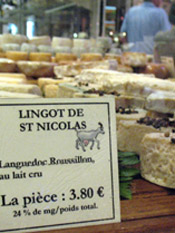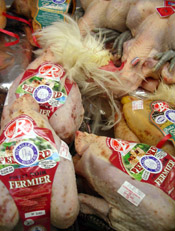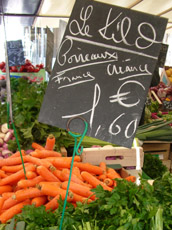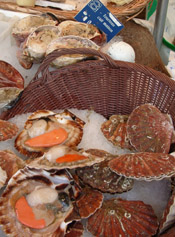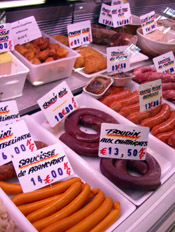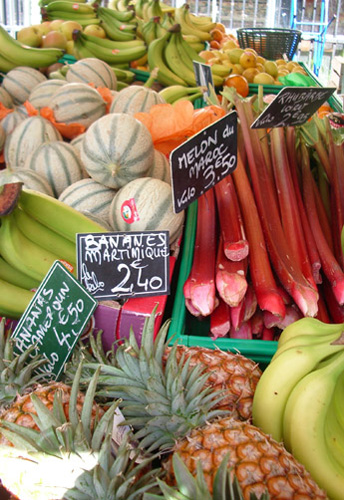A City Cook in a French Kitchen
Shopping Paris Food Markets
When Cole Porter wrote "I love Paris in the springtime," I doubt that he was thinking about white asparagus. But this favorite French spring vegetable was just one of many lures when I recently got to spend nearly two weeks shopping in the truly remarkable and inspiring food markets of Paris.
My dear husband was being a generous friend when he asked for lunch in Paris as a gift for a milestone birthday. That's because I got to share the gift. While the dollar/Euro exchange rate is choking, with a little planning and flexibility, we managed to have our trip without doing too much damage. We rented a small apartment on Ile Saint Louis and I cooked most of our meals.
Les Marchés de Paris
New York has its Greenmarkets but Paris started it all in the 5th century with its urban markets. Open year-round across the city's 20 arrondissements, these extraordinary outdoor and indoor markets bring the bounty of French and global foods to Parisians. In the past I had strolled through these markets as if they were museums since I'd have no kitchen in my tiny hotel room. I'd try to satisfy the urge to shop with a little souvenir bag of sea salt or a jar of honey. But on this trip having an apartment gave me the chance to buy whatever was tempting.
The open air markets are held every day but Monday, rotating around different neighborhoods with farmers and producers making regular appearances so that they can establish a clientele. Being outdoors, these markets transform urban landscapes into festive destinations. At the huge (more than 200 merchants) and extraordinary Richard Lenoir market held every Sunday adjacent to the roundabout at the Bastille opera house, it's common to find jugglers and accordion players charming the shoppers taking their breaks at one of the small fountain plazas that interrupt the long double rows of tented vendors. Families come for both serious shopping and an urban outing, to see friends and gossip, to make their weekly visit to a favorite vendor, and to showcase Paris as a uniquely livable and civilized world city.
It was at this market that I had my most recent moment of why I love the French and why I appreciate their warm formality. I was paying a vegetable farmer for a huge bag of peas and a bunch of white-tipped radishes and he owed me 10 cents in change. When I waved off the tiny copper Euro coin, he insisted that he do right by me and with a smile and a bow, instead handed over a small bunch of celery as if it were a bouquet.
Besides the Richard Lenoir market, my other favorite is the organic market held at Boulevard Raspail in the 6th arrondissement. With both conventional and organic produce, plus cheese, meats, seafood and baked goods, this outdoor market is held on Fridays and Sundays along the boulevard, between rue de Rennes and rue du Cherche-Midi. The neighborhood is stylish, which adds to the people watching. But the foods, especially what is called "bio" or "biologique" makes this the most popular organic market in the city.
Large or small, these outdoor markets are notable for in-season fruits and vegetables; proud producers of meats, cheese and fish; cooked meats and roasted chickens ready to bring to your table; cases filled with regional specialties like Gascogny ducks, cured hams from the southwest, or Normandy apple tarts; and eggs sold based upon what you'll use them for -- the producer will help you choose what's best.
Unlike those outdoors, the covered markets are food halls, with merchants established in stalls like an indoor mall. The quality is equally superb and many of the covered markets are partnered with an outdoor market, as at the Aligre Market in the 12th arrondissement, located at rue d'Aligre off rue Saint Antoine. Paris is a northern city and the winters can be raw and grim so having the choice of indoor markets benefit both the vendors and the customers.
If you're interesting in learning more about the markets in Paris or are planning a trip there soon, there is a splendid book called Paris in a Basket by Nicolle Aimee Meyer and Amanda Pilar Smith. It was published in 2000 and seems to be out of print, but copies can be found through Amazon. This book details all the outdoor and indoor markets, including a really handy chart that notes all the markets by arrondissement, day of the week, and size. It also has recipes and best of all, really gorgeous and tempting photographs. It just might get you to buy a ticket and fly to France.
Paris Shopping Tips
- Bring cash. A few merchants take credit cards but it's rare. You more often find credit cards taken at the indoor markets. The farmers at the outdoor markets not only don't take cards, they will be very appreciative if you have small bills and one and two Euro coins.
- The markets tend to be open from 8:00 a.m. to around 1:00 p.m. or when their wares sell out. Go earlier for smaller crowds and the best selections.
- Most merchants will have plastic bags for individual items, but you will be glad if you bring your own bigger shopping sacks.
- Ask first before you touch. In a practice different than what we're accustomed to here, many merchants will choose and bag your items. You can point out the particular pear or tomato that you prefer, but the merchant will do the touching. There are exceptions to this, but the merchant will let you know if you can do your own bagging.
- If daunted by the metric system, here's a tip: A kilogram is 2.2 pounds. So if you want a pound of something, simply ask for "un demi kilo" or a half-kilogram. It's a common request. Many of the vendors are obviously familiar with tourists trying to buy and most are wonderfully helpful in printing out and showing you a receipt so you can know what to pay.
- Try something new and unfamiliar. At many of the outdoor markets the poissoniers, or seafood merchants, will have scallops still in their shells with the bright orange roe, something nearly impossible to find in the U.S. The cheese producers will have raw milk cheeses that are not exported here. Some merchants are specialists in potatoes or mushrooms, selling varieties that are only regional or local. You'll see unfamiliar salad greens and melons. It's an adventure you can only have in Paris.
Other Paris Food Shopping Destinations
Every neighborhood, sometimes every block, will have a full collection of food merchants offering nearly anything you'd want. It's common to find a row of shops clustered together: bakery, butcher, fish store, a florist, and an appealing traiteur or a market that sells prepared foods plus cheese, charcuterie, olive oils and vinegars, bottled water, and most things you can't otherwise get at a fish or meat market.
While you can find consistently excellent prepared foods and ingredients at all these small shops, there are some food stores that are worth putting on your shopping map. As Michelin would say, they're "worth a journey."
- La Grande Epicerie. 38, rue du Sèvres (7th)
This very well may be the best food store in the entire world. Across the street from department store Bon Marché on the corner of rue de Sèvres at rue du Bac in the 7th arrondissement, this huge store claims over 5,000 different items in their grocery department. This is the place to go if you're in Paris with a craving for Tex-Mex or Italian because the store includes favorite ingredients from around the world. But what I love are their fresh ingredients: butchers, wearing the traditional apron tied with only one strap attached, so meticulously cutting, trimming and preparing regional meats and poultry like Bresse chickens and grass fed lamb and beef; a sprawling charcuterie department with sausages and patés, some wrapped in pastry "en croute;" smoked fish and caviar; fresh pastas; over 200 cheeses; and so much more. Their wine department, with more than 2000 choices, competes with the best vintners in Paris.
- Barthelémy. 51, rue de Grenelle (7th)
Famed for their chevres, this tiny shop sells all types of cheeses, plus yogurt and a few companions, like honey and jams. It shares the block with two chocolate shops, two wine stores, a small but resourceful little grocery market and around the corner on rue du Bac, butchers including one that has freshly spit-roasted chickens, a fish market, a florist, and a very nice and appealing "traiteur."
- Quatrehomme: la Maison du Fromage. 3 locations: 62, rue de Sèvres (7th); 215, rue de Tolbiac (13th); 9, rue du Ponteau (18th)
Gorgeous selection, grand varieties and rare regional choices. Look for their pillow-soft Saint Félicien, a round raw cow's milk cheese from the Rhone-Alps region of France; hard to find in the U.S., this slightly sour soft cheese ripens to a nearly runny finish and has a rich, forward flavor. They also have a small charcuterie selection and a few cooked items like savory tarts made with chevre, intense tomatoes and thin slices of eggplant.
- Poilâne. 2 locations: 8, rue du Cherche-Midi (6th), 49, blvd. de Grenelle (15th)
Made famous by their wood-fire oven-baked artisanal quality with the unique recipes and baking style of the passionate Lionel Poilâne. His famous French sourdough loaves continue to be baked and sold at the original shop but the breads are also shipped fresh all over the world (in New York the large, tender, full-flavored loaves are available at Fairway). I have a particular weakness for the bakery's apple turnovers made with a pastry dough that seems to be a cross between puff pastry and a traditional pate brisée; unfortunate for my palate but lucky for my waistline, these are not sold outside their Paris shops.
- Kayser. Locations include: 18, rue du Bac (7th), 87 rue d'Assas (6th), 10 rue de l'Ancienne Comédie (6th), 85 boulevard Malesherbes (8th), 16, rue des Petits Carreraux (2nd).
Eric Kayser is the new star of master French bread bakers. His 15 bakeries across Paris are always fronted with long lines and the wait is worth it: his breads are traditional yet full of exceptional flavor.
- Ladurée. 3 locations: 16, rue Royale (8th), 75, avenue des Champs Elysées (8th),
21, rue Bonaparte (6th)
Artful chocolates and pastries but the king here are the colorful and precious macaroons that come in traditional flavors like chocolate, lemon and pistachio, but also creations like apricot ginger, java pepper and champagne. The texture is both paper-thin crisp and soft at the same time and will forever change what you think a cookie can be.
Spring Ingredients and Birthday Meals
So what did I cook in Paris as we celebrated my husband's birthday? Well, I never did buy the white asparagus but only because I wanted them with hollandaise sauce and I wasn't confident I could make this buttery emulsion in a strange kitchen lacking a whisk. Instead I opted for them in a restaurant where they're served as a main course, not a side.
Heading to a rented kitchen, I had no idea what to find in terms of pots, pans and tools. I thought I could manage if I had the essentials so in my checked luggage I brought a chef's knife (not my favorite Wusthof but still, one that I liked), an instant thermometer for cooking meats, a generous length of butcher's twine, and small containers of salt, pepper and red wine vinegar so that I didn't have to locally buy more than I'd need for the meals I'd be cooking.
I roasted a small piece of lamb I bought at la Grande Epicerie, the loin still on the bone, which I stuffed with a paste of young spring garlic and olive oil and tied with a piece of twine. I set the oven to 180º C, which is about equal to 350º F, and after 45 minutes, checked it for an internal temp of 130º F. In a separate oven proof baking dish I used the remaining minced garlic and olive oil to coat some small, beautifully unfamiliar potatoes and roasted them along with the lamb until they became brown, crisp and tender. And on the convection cook top -- an adjustment for me as I have always cooked with a gas stove -- dark green haricots verts cooked to tenderness and served with sweet butter bought at the Raspail organic market. To start we had a small salad of tiny spring peppery arugula and slices of white mushrooms, dressed only with a squeeze of lemon and a little olive oil.
Another meal was slices of roast pork that I bought already cooked at the Richard Lenoir market. I added early spring peas and a gratin of sliced zucchini and potatoes. One day I made a pasta dish of bright yellow fresh egg fettucine tossed with quickly sautéed spring vegetables -- zucchini, beans, tomatoes and thin slices of red onion. We bought slices of a cheese and vegetable tart to have with a large salad of light green and lacey frisée lettuce tossed with thick chunks of rendered bacon and a drizzle of red wine vinegar. My favorite snack was always crisp radishes on a piece of buttered baguette. For dessert there were wedges of acutely sweet melon and bowls of the first of the season strawberries.
And with everything, regional wines, plates of cheese, slices of paté, and lots of splendid bread.
If it's crossing your mind, a personal note: I lost two pounds. I'm convinced that good food is more satisfying and we eat less. Or maybe it was all that walking, carrying canvas bags filled with French ingredients.
Beyond the markets, what will be my lingering memories of these days spent as a city cook in a French kitchen? Buying two baguettes at a time because I'd know I'd devour half of one while walking back from the bakery. Sipping a juice glass filled with ice-cold Champagne as I cooked. And after lunch, spending a late afternoon at the Luxembourg Gardens, ignoring my book to watch children sailing homemade boats on the small pond and listening to a gathering of friends softly strumming Antonio Carlos Jobim samba music, musicians playing for their own joy.
